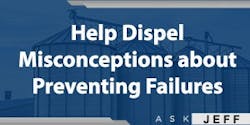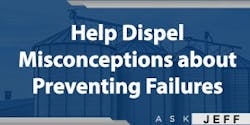Rochelle, maintenance manager, WY
Answer: Hi, Rochelle, and welcome to your new role. The reality is that the maintenance function cannot prevent all failures. It’s a myth that we have not yet been able to dispel completely. John Moubray in his book defines maintenance as causing the asset to continue to do whatever the user wants it to do in its present operating context. He also notes that maintenance is about avoiding, reducing, or eliminating the consequences of failures.
While some time-based overhauls are an appropriate strategy depending on the operating context of your assets, you can also disturb an otherwise stable system and introduce failure by engaging in these. From RCM, we know that upward of 70% of failures fall under the header of infant or early mortality – the result of intrusive maintenance tasks that involved human error or bad replacement parts, for example. Author and maintenance expert Winston Ledet has written that upward of 84% of failures result from poor work behaviors. Realize that most failures are random.
Looking at the the P-F curve, we can conclude that time-based maintenance is better replaced by condition-based maintenance. This means that corrective repairs are made based on the condition of the asset or part. We can use predictive technologies to find potential failures sooner than we could by relying on human senses, but the potential for failure has to exist to be able to find it. To be successful in ensuring reliability, we need to eliminate or delay the potential for failure. I’ll add that many organizations also focus on planning and scheduling more work, but the ultimate goal is eliminating the need to plan and schedule work.
Accomplishing defect elimination means pushing even farther to the left on the curve from a design, installation, and operations perspective. The engineering function must design for reliability and properly install assets (motor bases, pipe stress, machinery alignment, etc.). From an operations perspective, we must correctly operate the asset within its design envelope using training, standard operating procedures, and auditing. From the maintenance perspective, leverage standardized work using precision procedures at the right frequency. Also, remember that more maintenance does not mean better maintenance: Intrusive approaches can sometimes do more harm than good. Consider the fact that overlubrication is a larger failure cause for assets as compared with underlubrication.
Given the new role, I encourage you to continue to seek out education on maintenance and reliability best practices. The Society for Maintenance & Reliability Professionals is a great resource; become a member and join the community. Become a certified maintenance and reliability professional (CMRP) to validate your knowledge. If I can help you more, please let me know.
Readers, what other suggestions do you have for Rochelle? What additional questions do you have? Email me at the address below, and I will respond or place your questions or comments with my answers here.
Talk soon,
Jeff Shiver, CMRP
If you have problems in the fields of maintenance, reliability, planning and scheduling, MRO storerooms, or leadership, contact Jeff Shiver with your question(s) here.
About the Author
Jeff Shiver
Founder and managing principal at People and Processes, Inc.
Jeff Shiver CMRP is a founder and managing principal at People and Processes, Inc. Jeff guides people to achieve success in maintenance and reliability practices using common sense approaches. Visit his website www.PeopleandProcesses.com, and contact him on LinkedIn at www.linkedin.com/in/jeffshiver or via email at [email protected].


